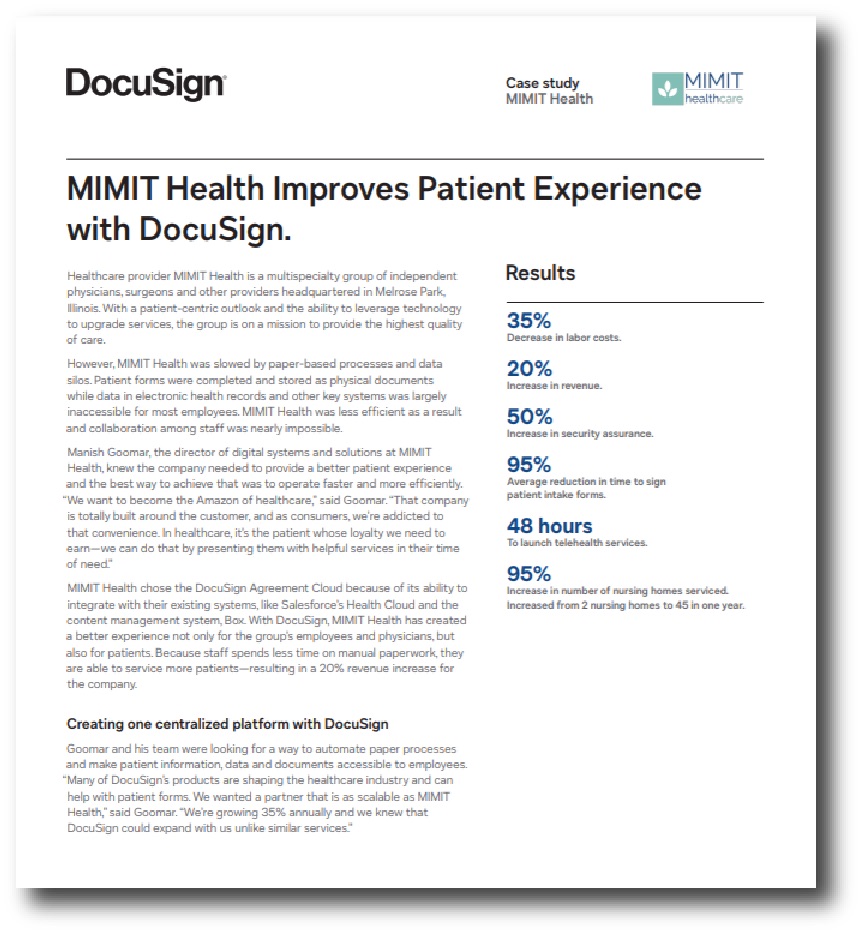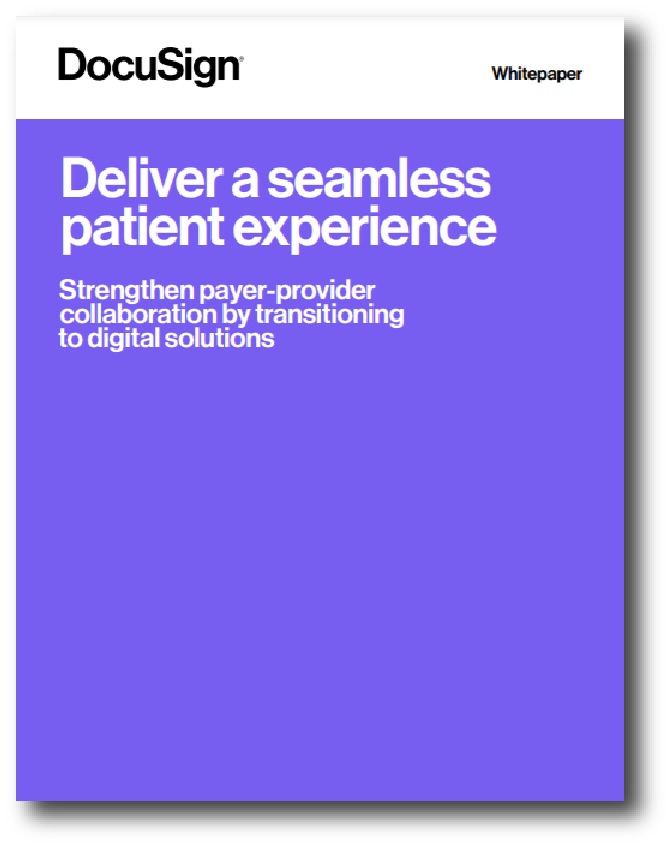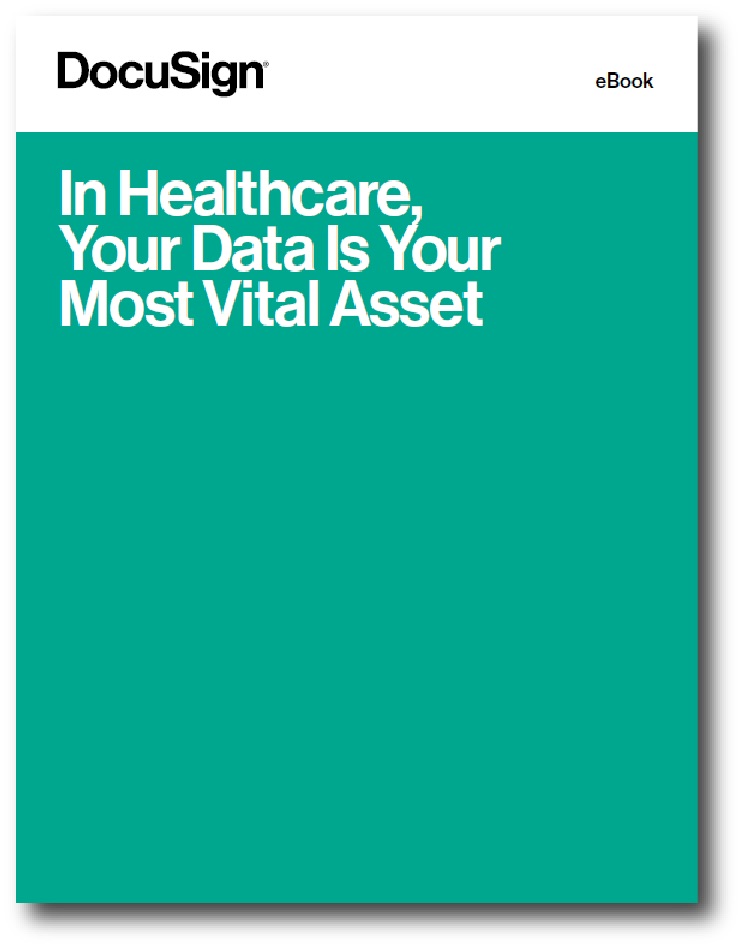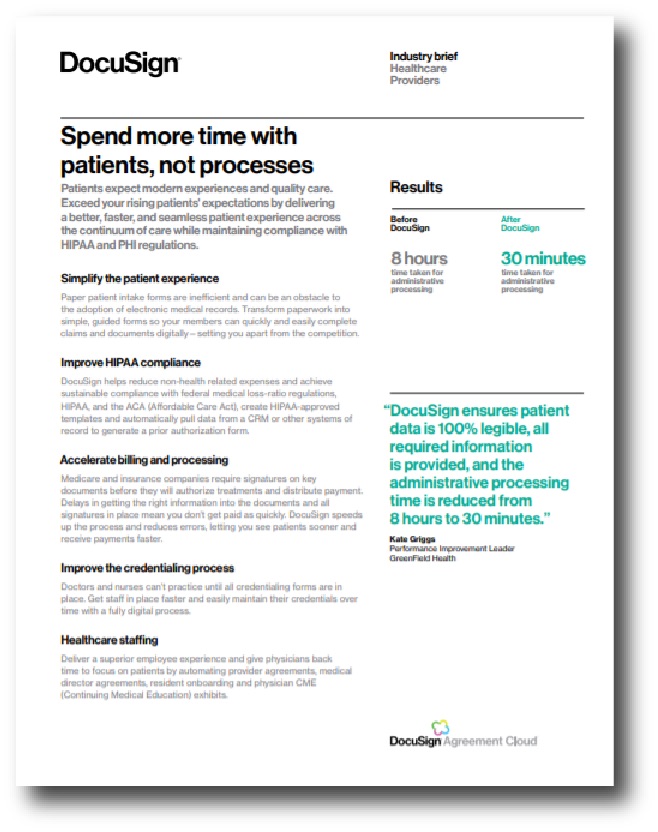DocuSign
SPONSORED
MIMIT Health, a multispecialty group of independent providers based in Melrose Park, Illinois, was slowed by manual processes and data silos. Because patient forms were still being stored in paper form and EMR data was inaccessible for most employees, collaboration between staff was almost impossible, which affected efficiency. MIMIT Health chose the DocuSign Agreement Cloud because it integrated with its existing systems to create a better experience for staff and patients alike.
SPONSORED
The Centers for Medicare and Medicaid Services have announced their initiative to turn healthcare offices into “fax-free zones” in favor of automated systems. Both payers and providers spend large amounts of time reviewing prior authorization paperwork and communicating via phone, fax and snail mail, which can cause significant delays in patient treatment. By digitizing their systems of agreement, payers and providers can dramatically reduce their cost structure, as well as lower the risk of errors and treatment delays so patients get the care they need when they need it.
SPONSORED
The digital transformation of healthcare includes a trend toward “data-driven” healthcare. But what does that mean for your practice and your patients? To become truly data-driven, your organization will need to overhaul and digitize outmoded paperwork-based operations. Although digitization may seem like a large and complex project, it’s a necessary step to establishing a source of verifiable, trustworthy data that can help streamline internal management, improve the patient experience and potentially save patients’ lives.
SPONSORED
Patients have come to expect a seamless digital experience from healthcare providers. Exceed those expectations by eliminating paperwork and presenting simple digital forms that improve HIPAA compliance, help patients get seen sooner and get providers paid faster.
SPONSORED
As healthcare organizations strive to improve the patient experience and reduce regulatory risk, legacy agreement processes can sometimes stand in the way of delivering on those goals. Waiting for responses from a patient’s care team takes an average of 30 minutes, which can raise care costs by an average of 75%. Legacy agreement processes can also lead to errors in data, which can contribute to providing a poor patient experience. Digitizing core processes can deliver a higher standard of care to patients, boost staff productivity and improve adherence to compliance requirements.
SPONSORED
Hear from leaders in the healthcare industry about how to leverage existing technology to unify healthcare workflows. Peter Urbain from DocuSign, the world’s #1 leader in creating a “system of agreements,” will provide best practices to improve care through technology. Theresa Bell from Kno2, a rapidly growing company that provides interoperability as a service will showcase how technological solutions can come together quickly to create a unified healthcare workflow.
SPONSORED
The patient-provider relationship is critical to improving patient outcomes. Yet only 11 percent of patients are satisfied with the time they spend with their primary care physician, and 42 percent of physicians are experiencing burnout. Administrative burdens and greater patient volumes are the key culprits - and implementing a connected technology strategy can relieve the pain.
SPONSORED
Patient Engagement
Improving population health and delivering personalized medicine all starts with research. But recruiting patients is an age-old problem: only 3 percent of cancer patients enroll in clinical trials, and more than half of clinical trials fail due to under-enrollment.
The Athena Breast Health Network, a University of California-wide collaboration based at UCSF, strives to change that paradigm.
SPONSORED
Revenue Cycle
As patient financial responsibility rises and technology puts healthcare information in patients' hands, healthcare is becoming much more consumer-focused. Extending a patient-focused strategy to the healthcare revenue cycle is key to boosting the bottom line, retaining and attracting patients, collecting patient financial responsibility, and improving patient satisfaction. To those ends, digitizing financial and billing documents helps healthcare organizations allocate funds faster and makes completing payment processes less strenuous for patients.
SPONSORED
Telehealth
Dr. Andrew Muth, a Clinical Informatics Fellow at Banner Health/University of Arizona, will discuss key aspects of this initiative, including waivers, consents, and HIPAA compliance. In addition, Dr. Muth will identify strategies for implementing telehealth programs at other organizations.









